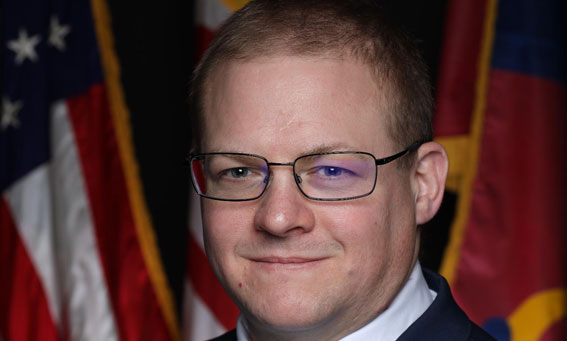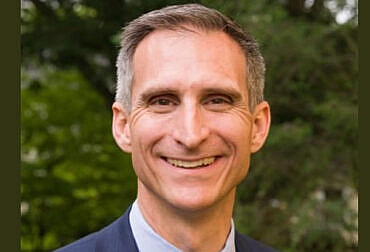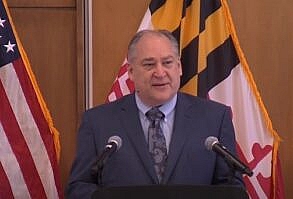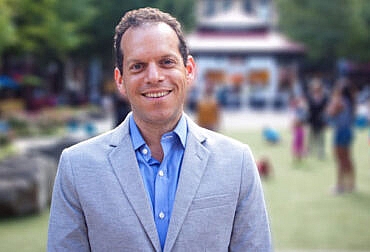Nagender Madavaram discussed with Assistant Chief Administrative Officer, Dr. Earl Stoddard about his role during Covid. Dr. Stoddard received his doctorate in cell and molecular biology from University of Pennsylvania, who has been a key figure during the County’s response to the COVID-19 efforts. He has served as the Director of the Montgomery County Office of Emergency Management & Homeland Security (OEMHS) since January 2016. In this capacity, he has overseen the County’s emergency preparedness, mitigation, response, recovery, and prevention programs. Previously, Dr. Stoddard served as the program administrator for Public Health Emergency Preparedness and Response (PHEPR) within the Montgomery County Department of Health and Human Services (DHHS) from 2014 to 2015. This is the first of a 2-part transcript of the interview which covered the topics of police, pay disparities in Fire Department, vaccine and farmers.
Nagender Madavaram: Congratulations for successfully managing the Emergency Management Department during pandemic and getting promoted to ACAO. I wish you all the best in your new job.
Earl Stoddard: Thank you very much.
Police:
Nagender Madavaram: You are dealing with police department as public safety is in your portfolio. Residents have concerns about the behavior of the Police in the County. In recent interview with Better MoCo, Councilmember Will Jawando said that he has unpleasant experiences with the County Police. If a Councilmember feels that the police is unfriendly, then who feels safe in the County? What steps the County needs to take to gain confidence of the public?
Earl Stoddard: I have talked to Councilmember Will Jawando about some of his experiences and his interest in seeing increased police accountability. I think we all want to see that, you know, I think part of my role is ensuring that we have a strong and safe community. Provide public safety in a manner that is both equitable and reflect equal treatment under the law. It’s sort of the way we all talk about it. Certainly, the County Executive has been very clear that he believes changes have to be made, particularly how we train and prepare our officers to respond on the streets. Surely, I think the coming Executive reflects the same principle that we have good police officers in Montgomery County. Not everyone perfect but certainly, we need to identify officers who are just not suited for this job. Train them to make sure that they suited for this job. You know, they may not work for the County moving forward if they can’t adjust to this new environment where we expect them to do their job and keep people safe. We also expect them to be fair and transparent about how they do that job. We entrust police officers with a ton of responsibility, but also with a ton of authority to enforce our laws. It comes with a great degree of requirement that there be public trust. So, in my role as an Assistant Chief Administrative Officer overseeing the public safety portfolio, one of the major areas that we’ve been focused on. Obviously, it is inclusive of the police work. It’s also, you know, places where we’ve relied on police to do certain things. It’s maybe not having police do those roles anymore. So, in some places it’s not just changing police behavior but it’s also changing what police are. This is particularly true when we talk about mental health issues and challenges where you know, they’re not really appropriately equipped to address mental health illness.
Obviously, one of the big roles that I have is to integrate a model where we have law enforcement and we also have mental health responders who are capable of responding in real time incidents. I think that will also reduce the number of incidents. Police is putting the positions where bad things happen, not just in terms of outcomes, but also how they interact with the public. A big part of my portfolio is just ensuring that; number one, we have police officers that are empowered and trained appropriately. Number two, holding them accountable in places where they don’t act as good stewards of the public trust. Number 3, not putting them in positions that they’re not appropriately equipped or trained to deal with having alternate resources that are available to address those problems.
Nagender Madavaram: I moved to this county in 1999. I did not get any ticket or trouble from the Police. I never had any problem with Montgomery County Police. Some ethnic groups are getting special attention from the Police for wrong reasons. How do you address this issue?
Earl Stoddard: I think certainly, there are the experience from police across the country, not just Montgomery County. I would certainly suggest that certainly, there are parts of the country where it is substantially worse. Not to say that there aren’t issues here where particularly our African American population is treated differently. I think that’s still a national problem with race and ethnicity being disproportionately and inappropriately included in how we administer our justice. So, we all have an inherent bias in the US. It’s really not trying to find people who don’t have inherent bias. It’s teaching people about their inherent bias and having them be able to be trained to the point where they do not allow their bias. You have systems of checks and balances to prevent their bias from disproportionately impacting the way they provide justice. So, to me, it’s a about training. It’s about having officers understand their own implicit biases. Having Police Department that looks like the population that it is policing. When you look at the different minority populations that comprise Montgomery County, I think it’s important that our Police Department looks like our residents. Police understands the experience of our residents by having more officers live in Montgomery County and policing their neighbors as opposed to living outside the county.
I think there are some things that we can do in Montgomery County to ensure that we have a Police Department that is more equitable. It provides public safety but also that understands and embraces its community more going forward. We’ve got to reimagine Public Safety Implementation Committee. That includes members from Police, there are about 60 officers that participate in the planning process. We could make changes across the board in our Police Department. We’ve also engaged with a nonprofit organization that works very closely with law enforcement. An audit of our Police Department, the preliminary results were released back in June, and they’re working on a final report that will be issued in February or March 2022 that provide a real road map for how we can improve the Police Department in Montgomery County. You know, public access to some of the information about traffic stops, interactions with police and use of force are required. I certainly think lot of steps that are in process that we’re doing right now or have already taken. There’s more work to do to improve.
Pay Disparities in Fire Department:
Nagender Madavaram: There is concern about pay disparities in Fire Department. Top leadership is getting high pay with overtime but firefighters, who are putting their lives are getting minimum pay. Is it true? What suggestions you make to improve the pay for firefighters?
Earl Stoddard: Yeah, so obviously you know compensation is a big part of public safety. I think we continue to work with our IAFF, our local firefighters’ union to provide fair and adequate compensation. I think it’s important to recognize when we talk about firefighting, about 75% of what our fire department does is actually paramedic or rescue services. So, firefighting is actually becoming a less of a critical part of our overall public safety issue because frankly, buildings are becoming safer. We’re having less fires overtime because of sprinkler systems. So, when we talk about the risk in the Fire Rescue Department, it’s actually more about a rescue service than it is a firefighting activity. If you look at the number of calls. I think we definitely agree that there needs to be fair and adequate pay for firefighters, paramedics and other first responders. That’s certainly something we continue to work on with our unions.
Obviously, we have seen the use of overtime in our Fire Department be utilized more than we would like. We tried actually to increase recruitment classes and other things that we have more firefighters and paramedics to cover the shifts because they have staffing standards across the board and make sure that we have our apparatus correctly stamped as opposed to relying on force holds overtime. Overall, we have more firefighters, paramedics and we have to roll out overtime less. I have not heard as many issues with compensation relates to recruitment and retention within the Fire Department as I have heard within the Police Department. I think that the pay scale in the Police Department is actually a little bit worse and that’s something that the County Executive is looking to address. I did look to address through his budget submission last year and will look to do so again. I think it’s certainly an issue that we’re going to be looking at within the Fire Department. I’m not sure it’s this big an issue in the Fire Department.
Nagender Madavaram: Main concern is top level leadership is charging unjustifiable overtime and getting more than 200,000 per annum whereas firefighter’s pay is very low. Nobody has a problem with overtime of rescue workers and firefighters who are on the field and saving lives.
Earl Stoddard: Yeah, so the issue is with upper-level management. It’s actually more often the captains that we receive the high pay. The top 20 compensated people in the County would often be about 50% senior management and department heads and the other 50% would often be usually Fire Department personnel. I think one of the big things to recognize that many of those captains have specialized unit training. For example, the hazardous materials team. You have to have experience and training that specialize to deal with hazardous materials. If you haven’t been trained and you’re not certified to be a hazardous materials operator, you can’t be do it as a junior officer. So, what ends up happening is because there’s only a limited number of people who have certain capabilities and training whether it’s swift water rescue or hazardous materials it narrows the pool of people who are eligible for certain overtime opportunities. It puts certain people they get paid a lot because they have to cover a lot of hours for the minimum staffing for some of the specialized units. So specialized units are something we’re looking at to see if there’s a way. We can broaden the training to allow for more people to qualify for work in special units.
Vaccine and Food Distribution:
Nagender Madavaram: Health and Human Services Department played vital role in the success of vaccination. Amazingly, food distribution is successful in difficult time. Farmers are donating vegetables and NGOs are supplying them to the needy people. It is very successful model. What are the challenges you encountered in controlling the deaths in the County?
Earl Stoddard: I would say our Department of Health and Human Services did incredible job across the board. Without question, they also were strongly supported by a number of nonprofit organizations who have been indispensable partners in doing both the vaccination efforts and the food distribution service. We established a food security task force during COVID-19 that was a partnership between Department Health and Human Services, Office of Emergency Management, and the Food Council. The Food Council is a nonprofit organization that receives county funding. We established that partnership because we recognized pretty early during COVID that was going to be a role for government and it was going to be a role for nonprofit. It had to be cohesive together to deliver as many opportunities for food to our residents as possible. We saw a tremendous number of organizations who had experience in food distribution and some that had no experience before. We obviously had many partners like the Capital Area Food Bank and other food veteran centers who were a huge part of that effort. There were smaller nonprofits, including just local churches and other faith-based organizations. Partnership with local organizations provided us a lot of opportunity to fill the gap that people had in terms of food. So that’s actually something we’re looking to memorialize after COVID that success that we had in the food distribution is something that we’re looking to expand on.
I know that there’s a supplemental appropriation for the County Council. Right now, it’s $6.8 million with part of that money, creating some additional long term accounting positions to help fill the role that we use. You know, it was so successful and so, food resilience is something we’re going to look to have a focus area on moving forward in partnership with obviously between the County Executive and County Council President Albornoz. We’ve been partnering very closely with his office on trying to expand out moving forward. In terms of food from farm to table, I think one of the biggest challenges that we experienced during COVID-19 that very little of the food is produced in Montgomery County. That’s a problem for resilience. That’s a problem with climate change impacts that we need to produce more locally and consume more of that locally. So, we’ve been working with the Office of Agriculture to try and develop programs that would incentivize local farmers to produce products that can be purchased locally in a local market. We need to dedicate some of their crop space to producing things that would be consumed locally. We not only can link up what’s produced locally but also, we can help feed people who are hungry. So, that is something we did very successfully during COVID and we’re looking to do more in the future. We think this is part of being a more resilient county, having a greater connection between the food that’s produced in Montgomery County and have it been consumed locally. So, it’s certainly something we’re very interested in expanding and being more successful.
Farmers:
Nagender Madavaram: Farmers are really helpful to food distribution system as they gave a lot.
Earl Stoddard: We want to create the incentive or commitment to farmers, if you produce this amount of produce, tomatoes or potatoes that we will purchase locally. We will buy them from you at this rate, and so they don’t have to worry about the shipping costs. You know, they don’t have to worry about storage and refrigeration. In some cases, we could purchase them locally and get them right out into our food pantries or other distribution places. The farmer is happy because they’re getting market and above market rates for their products. The people locally are happy as we’re giving them not just food but fresh and healthy food particularly for our young people. Now people, kids who are hungry do not earn well. Kids who are hungry are going less successful both in school and elsewhere. So obviously we’re looking to marry local farmers and local community. It’s a better outcome for everyone involved.
Nagender Madavaram: It is great proposition to give guaranty price to farmers for their produce. I volunteered and saw the generosity of local farmers who donated vegetables to nonprofit organizations. I found interesting thing that grocery stores are not buying the vegetables which are not meeting their standards. The rejected vegetables are edible but stores are not buying them. Farmers are trashing them until nonprofit organizations picked them up for needy people. It will be helpful to farmers if they get some price for their produce. If the County supports network of nonprofit organizations to pick up vegetables and supply to needy people that will help farmers as well as local community.
Earl Stoddard: I agree 100%. We need to keep more of our locally produced agricultural products. I mean the agriculture was a tremendous long-term investment in Montgomery County. We just need to double down effort by having more of the locally produced products are consumed locally. I think we can, like you said, our supermarkets here locally can consume products some level. The county in partnership that nonprofits can commit to purchasing more of the locally produced food that maybe those first stores don’t want but that we could turn around and put into more of our food provision. So, I think it’s sort of a perfect marriage between local production and local businesses, and our local nonprofits and communities of need.











